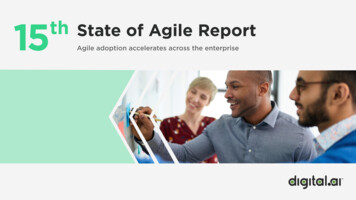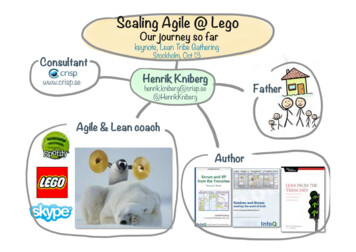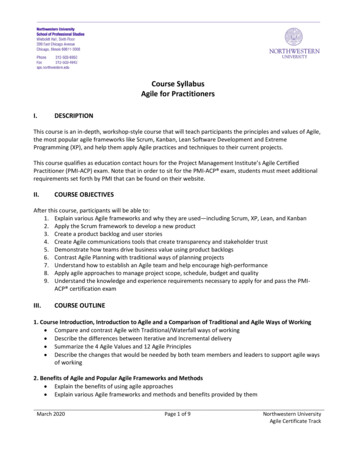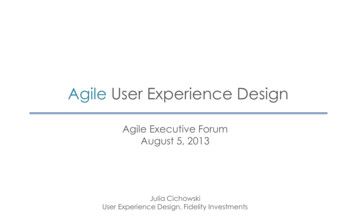
Transcription
15th State of Agile ReportAgile adoption accelerates across the enterprise
Table of ContentsExecutive Summary3What’s Trending?4Company Experience with Agile6Agile Adoption8Agile Challenges11Agile Techniques and Maturity13Scaling Agile16Agile Tooling17DevOps Initiatives18Improving DevOps Success19Value Stream Management20About the Survey21Demographics22
Executive SummaryWelcome to the 15th State of Agile Report, thelongest continuous annual series of reviews of agiletechniques and practices.stakeholders, they must bring new products tomarket faster and accelerate improvements toexisting solutions and services.This year’s report highlights several importantmilestones in Agile’s journey from its initialprinciples aimed at software development teamsto its current widescale adoption to drive businessvalue and deliver speed and quality in softwaredelivery.This report offers a chance to look at the role Agilehas played during this tumultuous period and toreflect on how the benefits of agile practices canhelp organizations adapt and excel in the pathahead.As we reach 20 years since the creation of the“Manifesto for Agile Software Development”, wefeel it is a good time to look back and reflect atthe remarkable journey Agile has experiencedover these past two decades.Since the global pandemic emerged in early 2020,organizations are now aware of the opportunitiesand challenges ahead and realize being successfulin the digital age requires agility in softwaredevelopment and delivery, as well as businessstrategy and operational execution. With today’senterprises under increased pressure to respondquickly to the needs of their customers andDigital.ai 15th State of Agile ReportAs you explore the 15th State of Agile Report forcurrent trends in agile software delivery with keyhighlights from past surveys, clearly Agile has thepotential to be a steadying force in uncertain times.To recognize the significance of the 15th editionof the State of Agile survey, we spoke with manynotable agile software delivery experts andinfluencers to get their take on the past, currentand future states of agile software delivery. You’llsee their views intermixed throughout the report,providing more depth and context to the findings.We’d also like to thank both Scrum.org and ScaledAgile for their help in distributing this year’s survey.3
What’s TrendingRemote/hybrid workforces require anew way of thinkingFor years, respondents to the State of Agilesurveys indicated a workforce becomingincreasingly distributed and the frequentoutsourcing of work to external vendors locatedacross the globe. Unsurprisingly, this year’ssurvey saw a dramatic increase in this movetoward remote work and a clear indication thatthis direction isn’t temporary.remote in a post-COVID worldGartner also found that organizations will needto adapt to succeed, stating “The radicallydistributed software engineering resultingfrom the COVID-19 pandemic exposedprocess and skills gaps that impact theability of organizations to successfully deliverapplications. The ‘new normal’ will be led byorganizations that are able to quickly identifyand address the critical skills needed to drivetheir business.¹”56% favor a hybrid approach, returning toAgile goes mainstream Only 3% indicate they plan to return to theoffice full time ¼ of respondents say they will remain fullythe office regularly but not dailyThis mix of both remote and co-located workwill present a challenge for organizationslooking to continue to build on their successin 2021 and beyond. The State of Agile surveyrespondents aren’t alone in this realization.In reflecting on how COVID-19 has changed theglobal workforce, Gartner research found that,Digital.ai 15th State of Agile Report“In response to the pandemic, organizationsare accelerating the adoption of newprocesses, practices, and technologies tosupport changes to product and servicedelivery”.Perhaps fueled in part by an increasinglydistributed global workforce, this year’sreport sees an explosive increase in Agileadoption across the functions of the enterprise.Since the first report 15 years ago, we’ve seen asteady increase in the number of organizationsadopting agile practices and processes,both inside Development and within non-ITgroups including Finance, Human Resources,and Marketing.¹ Gartner, Inc.: “2021 Planning Guide for Agile Software Development and DevOps,” 9 October 2020, by analysts Bill Holz, Danny Brian, Peter Hyde, Sean Kenefick, Brad Dayley, Kevin Matheny4
This year’s findings indicate significantgrowth in Agile adoption withinsoftware development teams,increasing from 37% in 2020 to 84%in 2021.Growth in non-IT lines of business also rosesignificantly, doubling in adoption since last year’sreport. What’s stopping even broader adoption? Thesurvey shows no fewer than ten barriers to adoption,including: Inconsistencies in processesand practices 46% Cultural clashes43% General organizationalresistance to change 46%Despite these challenges, it’s clear that respondentscontinue to see the value of broadening Agileadoption as a way to achieve critical businessoutcomes. In fact, 2/3 of respondents identifiedmanaging priorities, visibility, or alignmentbetween business and IT as seeing the strongestpositive impact from Agile adoption. Conversely,organizational culture — once regularly cited as abarrier to adoption — is no longer a top challenge,with only slightly more than four in 10 respondentsidentifying it as a barrier.Digital.ai 15th State of Agile ReportDriving DevOps and value streammanagement initiativesMore than ever, organizations are under increasingpressure to deliver features that provide greatervalue and new solutions that improve efficiency andreliability. Year after year, more respondents tell ustheir organizations view both DevOps and valuestream management (VSM) initiatives as essential toachieving these goals.3/4of respondents say DevOps transformationis important or very important to theirorganization2/3are involved with implementing or planninga VSM initiative“We placed a focus on the business andtransforming how we work first and foremost.We used that as a catalyst to begin to drive agilitythrough the organization — speed of decisionmaking, clarity of focus on purpose, showingthat we can deliver incremental value — withoutforgoing the larger picture.”David Paine, Domain Information Office ToyotaFinancial Services5
Company Experience with AgileHow long has your company been practicing agile? 1 year7%4%How many of your company’s teams have adoptedagile practices?Don’t know2%3%Not practicing agileNoneAll1-2 years52%18%22%32%5 yearsLess than half33%46%34%More than half3-5 years65%94%report their companyis practicing Agile.Digital.ai 15th State of Agile Reportsay their company has significantexperience with Agile.Over half of respondents (52%)say either a majority or all of theircompany’s teams have adopted Agile.6
Company Experience with AgileWhich areas of your organization have adoptedagile principles and practices?86%Software ��ll be back in the office on aregular basis but not full timeSecurity56%25%We went remote duringCOVID-19 and expect toremain remoteHuman Resources11%Sales/Sales Ops10%Finance10%Hardware development2%3%We’ll be back in theoffice full timeWe’ve always been remoteand expect to remain remote16%6%How do you see the distribution of your agileteam changing post-COVID-19?OtherNoneDigital.ai 15th State of Agile ReportMultiple industry studies have shown a growth in distributed teams.This survey indicates that 89% of teams are geographically distributed.Remote work isn’t just a temporary trend during COVID-19 — a mere3% say they will be back in the office all of the time after COVID-19.7
Agile AdoptionSupported by shiftstoward value streammanagement andbusiness agility, surveyrespondents indicatetheir organizations arenow better ableto meet their agiletransformationgoals based on theircontinued adoption ofagile practices.The two most urgent reasonsfor adopting Agile are thespeed and flexibility requiredby working environmentsthat continue to be bothunpredictable and volatile.These are closely followedby a continued need to focuson alignment across teamsto streamline the softwaredelivery process.What were the most important reasons for adopting agile within your team or organization?64%Enhance ability to manage changing priorities64%Accelerate software delivery47%Increase team productivity47%Improve business and IT alignment42%Enhance software quality41%Enhance delivery predictability40%Improve project visibility39%Reduce project risk39%Better respond to volatile market conditions35%Improve team morale24%Improve engineering disciplineSTATE OF AGILE LOOK BACK24%Better manage distributed teams23%Reduce project cost20%Increase software maintainabilityThe reasons organizations want toadopt Agile remain unchanged forseveral years. However, we haveseen an increase in their ability tomeet those goals, particularly asDevOps and agile practices expandacross the organization.5%Digital.ai 15th State of Agile ReportOther8
Agile AdoptionBusiness and IT alignment and visibility across agile teams werehighlighted as key to leading agile adoption. 2/3 of respondentsidentified management, visibility, and alignment as receiving thestrongest positive impact from adopting agile approaches.When assessing the metrics organizations use to determine agiletransformation success, the survey shows three in five respondentslook to externally focused measures of success.Has the implementation of agile positively impactedeach of the following areas within your company?How does your organization measure success of agiletransformations?Digital.ai 15th State of Agile ReportManaging changing priorities70%59%Customer/user satisfactionVisibility70%58%Business valueBusiness/IT alignment66%50%Business objectives achievedDelivery speed/time to market64%48%On-time deliveryTeam productivity60%48%QualityTeam morale60%41%ProductivityManaging distributed teams52%41%Organizational culture/moralePredicitability51%39%Process improvementRisk reduction49%37%PredictabilitySoftware quality45%30%Project visibilityEngineering discipine45%19%Software maintainability35%10%Cost reduction23%4%Product scopeDon’t knowOther9
Agile AdoptionHow does your organization measure the success of agile delivery?Business value delivered49%Customer/user satisfaction49%45%VelocityPlanned vs. actual stories per iteration35%31%Team morale30%Budget vs. actual cost29%Cycle time28%Defects into production26%Planned vs. actual release datesIteration burndown25%Defects over time25%23%Burn-up chartWIP (Work in Progress)21%20%Release burndown19%Defect resolutionCustomer retention18%Agile delivery success is focused onexternal measures, with almost halfEstimation accuracy15%of respondents focused on businessRevenue sales impact15%value deliveredEarned value13%Cumulative flow chart13%Product utilization12%Test pass/fail over time12%11%Scope change in a releaseIndividual hours per iteration/weekDigital.ai 15th State of Agile Report49% and customersatisfaction 49%. Additionally,delivery velocity 45% is seen asan equally important measure ofAgile success.9%10
Agile Challenges“The future requires agile at scale, beingable to achieve DevOps, being able toachieve flow, have everybody operatingwith an agile mindset, having the leadersunderstand that this is a new way ofworking — they need to get it.”Dean Leffingwell, Co-founderand Chief Methodologist ofScaled AgileOrganizations face a variety ofchallenges as they introduceagile techniques, practices,and tools.In fact, 30% of respondentsidentified no fewer than tendifferent challenges faced whileadopting Agile.Digital.ai 15th State of Agile ReportThe most significant Agile adoption barriersinclude: Inconsistencies in processes andpractices 46% Cultural clashes 43% General organizational resistance tochange 42% Lack of skills and experience 42% Absence of leadership participation 41% Inadequate management support andsponsorship 40%The key challenges organizations facewhen adopting Agile have remained largelyunchanged for the past several years.Challenges with organizational culture,resistance to change, and lack of supportand skills continue to be problems.11
Agile ChallengesWhat are the most significant barriers to adopting and scaling agile practices in your current organization?46%Inconsistent processes and practices across teams43%Organizational culture at odds with agile values42%General organization resistence to change42%Lack of skills/experience with agile methods41%Not enough leadership participation40%Inadequate management support and sponsership35%Insufficient training and education35%Pervasiveness of traditional development methods31%Lack of business/customer/product30%Fragmented tooling and project related data/measurements22%Unwilling to admit mistakes and learn from delivery failure17%Minimal collaboration and knowledge pairing13%Regulatory compliance orgovernment issue7%Don’t know5%OtherDigital.ai 15th State of Agile ReportSTATE OF AGILE LOOK BACKOrganizational culture and agile values arebecoming more aligned. A few years ago,more than eight out of 10 respondentsidentified culture as a significant barrier toagile adoption. That number now stands atslightly more than four in 10.12
Agile Techniques and MaturityThe survey once again highlighted Scrum as the most popular agileapproach with 66% identifying it as the methodology they followmost closely, with an additional 15% who follow derivations of Scrum(ScrumBan 9% and Scrum/XP 6%).In terms of agile techniques and practices, at leastfour out of five respondents cited: Daily standups 87%, Retrospectives 83%, andWhich agile methodology do you follow most closely atthe team level?KanbanScrumBan9%Scrum/XP Hybrid4% Iterative1% Extreme Programming (XP)1% Lean Startup6% 6%5%Other Sprint/iteration planning 83%were used.In addition: Kanban boards 77%, Task boards 67%, and Spreadsheets 66% are allwidely used for Agile planning.2% Don’t know66%ScrumDigital.ai 15th State of Agile Report13
Agile Techniques and MaturitySTATE OF AGILE LOOK BACKOver the years, the State of Agile surveydetermined “practices used” as an indication ofthe maturity of Agile adoption. Most notably, wehave seen the use of Scrum increase from 40%of respondents in the first survey to 66% in themost recent. Other approaches such as extremeprogramming (XP) dropped from use by almost aquarter of respondents to less than 1% today.In contrast, the use of specific individual agile techniques andpractices remained relatively constant across the surveys. Keyactivities including daily standups and retrospectives have been at theheart of agile approaches, supported by sprint planning and reviews.Perhaps the most significant growth trend has been the use of kanbanboards for workflow management and visualization. This approach isnow used by 61% of respondents, steadily increasing from 6% in thefirst survey.Digital.ai 15th State of Agile Report14
Agile Techniques and MaturityAlmost nine in 10 respondents use daily standups while over four infive use retrospectives and sprint/iteration planning.3/4 of respondents say they use kanban boards while 2/3 useWhich of the following agile techniques and practicesdoes your organization use?Which agile planning and delivery tools do youcurrently use?Daily standup77%Kanban board67%Taskboard66%Spreadsheet64%Agile Project Management ToolRetrospectives83%Sprint/Iteration planning83%Sprint/iteration reviews81%62%Bug TrackerShort iterations63%62%WikiKanban61%58%Product Roadmapping54%Automated Build ToolPlanning Poker/Team Estimation58%54%Unit Test ToolDedicated customer/product owner56%53%Continuous Integration Tool51%Wireframes47%Release/Deployment Automation Tool43%Requirements Management Tool43%Traditional Product Management Tool39%Product and Portfolio Management (PPM) Tool37%Static Analysis36%Story Mapping ToolRelease planning54%Product roadmapping52%Single team51%Frequent releases51%Story mapping40%Agile Portfolio planning32%35%Automated Acceptance Test ToolCommon work area24%29%Timecards24%Refactoring Tool19%Index Cards18%Customer Idea Management ToolAgile/Lean UXOtherDigital.ai 15th State of Agile Report87%taskboards and spreadsheets.23%3%15
“I would say that the number onechallenge facing capital ‘A’ Agile today isa lack of awareness of systems thinking.And the fact that we have all these teamsand organizations who have adopted agileand agile frameworks, be it Scrum or SAFeor XP, are doing so in one part of thesystem.”Evan Leybourn, CEO and Founder BusinessAgility Institute“With respect to software development,I think at the team level agile is widelypracticed It’s the dominant form ofhow teams organize. In many IT teams,the alignment to business outcomes ismissing.”Dave West, CEO at Scrum.orgSTATE OF AGILE LOOK BACK807060504030SAFe 2010ScrumScaling AgileWhile a wide range of scalingframeworks are in use, theScaled Agile Framework (SAFe )continues to be the most popularwith 37% of respondentsidentifying it as the frameworkthey most closely follow. SAFe significantly outdistances the nextnearest scaling method, Scrum@Scale/Scrum of Scrums (9%).Over the last several years, therehas been increasing awarenessof both the opportunities andchallenges offered by scaling agilepractices across the organization.Initially widely addressed througha “Scrum of Scrums” approach,over the past five State of Agilesurveys we have seen the useof SAFe grow significantly tobecome the dominant approach,in use by more than ⅓ ofrespondents. However, morethan one in five respondents stilldo not identify with any scaledframework.Which framework does your organization follow tohelp scale agile?37%Scaled Agile Framework (SAFe)9%Scrum@Scale/Scrum of Scrums6%Enterprise Scrum5%Spotify Model3%Agile Portfolio Management (APM)3%Disciplined Agile (DA)3%Large Scale Scrum (LeSS)3%Nexus2%Lean Management1%19%8%Recipes for Agile Governance in the Enterprise (RAGE)Don’t knowOther0Digital.ai 15th State of Agile Report16
Agile ToolingAgile practitioners rely on a wide variety of tools to support agile techniques and practices. However, the surveyindicated that two tools, Atlassian Jira (81%) and Digital.ai Agility (70%), were the most highly recommended tocolleagues by their users.What tools do you use to manage agile projects?81%Atlassian JIRA70%Digital.ai Agility (formerly VersionOne)66%Azure DevOps62%CA Agile Central59%Trello52%Atlassian JIRA Align48%Google Docs43%Target Process40%LeanKit39%IBM Rational Team Concert38%HP Agile Manager35%Microsoft TFS35%Microsoft Project34%Bugzilla32%Microsoft Excel31%Pivotal Tracker28%HP Quality Center/ALM25%Hansoft21%Collabnet i 15th State of Agile ReportSTATE OF AGILE LOOK BACKFrom the earliest days of the State of Agilesurvey, tool support has been a key componentdetermining the success of agile.A varied collection of tools is employed, rangingfrom generic planning and management tools(e.g., Microsoft Office) to specialized commercialofferings.In the past few years, Atlassian Jira and Digital.ai Agility have seen the highest percentage ofrecommendations from their users.17
DevOps Initiatives“I think you would struggle to become a digital enterprisewithout using Agile and DevOps.”Helen Beal, Chief Ambassador DevOps Institute and Chair ofthe Value Stream Management ConsortiumBroad organizational recognition and acceptanceof DevOps continues to grow. In the currentsurvey, 75% of respondents indicate DevOps isimportant or very important to their organizationwith only 9% stating it has no importance.With 74% of respondents stating they eitherhave a current DevOps initiative or are planningone, DevOps maintains a steady strong level ofinvestment.Do you have a DevOps initiative currently in process?No Not importantDon’t know13%56%Very important13%18%How important is DevOps within your organization?9%Somewhatimportant16%Planninga DevOpsinitiativeSTATE OF AGILE LOOK BACKThe interest in DevOps has been a notable44%trend throughout the past few editions ofthis survey. Over the past four years, thepercentage of companies who considerImportant31%DevOps transformation “Very Important”has continued to increase (33% to 42%)while those who believe DevOps to be“Somewhat Important” or “Not Important”has decreased (35% to 25%).Digital.ai 15th State of Agile Report18
Improving DevOps SuccessDevOps helps increase software delivery frequency and reliability while reducing bugs in production.Accelerating software delivery and improving quality are shown to be the top measures of success forDevOps transformation initiatives.2/3 of respondents say accelerated delivery speed is the most critical measure of success for theirDevOps transformation initiatives while three in five say it is improved quality.What are the most critical measures of success for your DevOpstransformation initiatives?67%61%Improved quality47%Reduce risk45%Increased customer satisfaction43%Improved relationship between “Dev” and “Ops”35%Decreased It costsSTATE OF AGILE LOOK BACK35%Delivery aligned with business objectives32%Increased visibility of flow of valueto usersOver the last several years, delivery speed, improved28%Ensure compliance/governancegovernance have steadily increased in importance,7%Digital.ai 15th State of Agile ReportAccelerated delivery speedquality, customer satisfaction, and compliance/reflecting a growing focus on outward-facing metricsOtherthat directly impact customer experience.19
Value Stream Management“While value streams are a critical aspect of lean methods, it’s acommon misconception that improved efficiency is their primaryobjective. Every value stream’s goal is to deliver the maximumamount of value to the customer, with the highest possible qualityand delight in the shortest sustainable lead time.”Which of the following best describes your organization’sadoption of VSM?14%Expanding implementation7%Implemented,not expanding21%Currently implementing14%Planning to implement in the next 12months23%Interested, but no near-term plans to implement6%No interest15%Don’t knowRichard Knaster, Chief Scientist, Value Stream Management, Digital.aiIntroduced in last year’s State of Agile survey, valuestream management continues to be an importantfocus for respondents. As defined in the currentstudy, VSM is a combination of the people, processes,and technology that maps, optimizes, visualizes,measures, and governs the flow of business value(delivered by epic, stories, work items) using end-toend enterprise software delivery pipelines spanningfrom idea through development and into production.Consistent with last year, more than half (56%) of respondents haveimplemented or are planning to implement VSM and an additional 23%report their organization is interested in VSM. This data is consistentwith Gartner research that predicts “By 2023, 70% of organizations willuse value stream management to improve flow in the DevOps pipeline,leading to faster delivery of customer value.²”² Gartner, Inc.: “2021 Planning Guide for Agile Software Development and DevOps,” 9 October 2020, by analysts Bill Holz, Danny Brian, Peter Hyde, Sean Kenefick, Brad Dayley, Kevin MathenyDigital.ai 15th State of Agile Report20
About the SurveyThe 15th State of Agile survey was conductedbetween February and April 2021.Sponsored by Digital.ai, individuals across a broadrange of industries in the global software developmentcommunities were invited to participate.A total of 4,182 responses were received with 1,382complete survey responses collected, analyzed, andprepared into a summary report by Regina CorsoConsulting, an independent survey consultancy.Unlike previous years, this survey was conductedentirely online due to the global pandemic. Toencourage the widest possible participation, thesurvey was promoted by Digital.ai through a varietyof online channels.Digital.ai 15th State of Agile Report21
DemographicsThe 15th Annual State of Agile survey reflects the input of Agilepractitioners of all levels, from more than 100 countries, incompanies large and small and across a wide range of domains.To ensure broad access, all responses were collected online, andthe survey was broadly advertised through social media channels,website requests, blog postings, and email to relevant curatedmailing lists.This year, two in fiverespondents comefrom companies with1,000 employees orless and ¼ work incompanies with over20,000 employees.Despite the changing approach to gathering data and publicizing the survey,company size has held relatively steady over the past five years, providing aconsistent foundation for the survey.How many employees are in your entire company?39%1-1,000Over ⅓ of respondents say the software organization in theircompany is between 101 and 1,000 people and ⅓ say it’s lessthan 100 people.It is notable that over the past several years, respondentsto this survey have consistently been drawn from small,medium, and large software teams.How many people in your organization (includingcontractors) are responsible for planning, developing,testing, and delivering software?25%19%17%35%33%17%15%Over 20,0001,001-5,0005,001-20,000101-1,000Less than 100Over 5,0001,001-5,000Digital.ai 15th State of Agile Report22
DemographicsRespondents are evenly dispersed across North America, Europe,and the rest of the world.A majority of respondents (38%) describe themselves as ScrumMasters or Internal Coaches. This trend has been consistent over the pastseveral years of the State of Agile survey.Where are you located?Which role best describes your current position?Daily standupNorth AmericaEurope39%37%38%Scrum Master or Internal Coach14%Development Leadership13%Project/Program Manager8%Asia14%6%South AmericaAustralia/New Zealand3%7%Digital.ai 15th State of Agile Report2%Product Manager/Product Owner6%Development Team Member4%C Level Exec3%Business Analyst2%AfricaExternal Consultant/Trainer6%DevOpsOther23
Digital.ai 15th State of Agile Report 3 Executive Summary Welcome to the 15th State of Agile Report, the longest continuous annual series of reviews of agile techniques and practices. This year’s report highlights several important milestones in Agile’s journey from its initial princi










